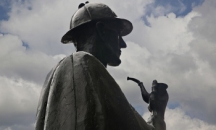Talking Statues
Date uploaded: August 20, 2014
Sing London have commissioned some of the nation's most celebrated writers and actors to animate 35 public statues across London and Manchester. Using drama, humour and location technology, Talking Statues breathes new life into famous public art statues in these two city locations.
Visitors to the city will be able to swipe their smart phones over tags on the selected statues and receive a call from the likes of Queen Victoria, Peter Pan or Abe Lincoln. This project has been made possible with support from the Digital Reasearch and Development Fund for the Arts.
High profile writers were signed up to put words into the statues' mouths, while familiar figures of stage and screen recorded the monologues that give voice to 35 majestic men and women (plus two cats and a goat), transforming them from stony strangers into fountains of living history for a year.
A marble child in Manchester Central Library, for instance, will produce a monologue written by Jacqueline Wilson and spoken by Dr Who's Jenna Coleman, while the first world war Tommy in London's Paddington Station has been brought to life by Tony Harrison and actor Patrick Stewart.
This use of technology aims to bring audiences physically as well as emotionally closer to the subjects. Once in front of a statue, a "heritage plaque" on its plinth offers viewers three ways to hear its story: a link to type into your web browser, a QR barcode or a near field communication (NFC) chip that can be tapped with any supporting phone to trigger a speech.
Aside from breathing new life into landmarks, the project is also designed to encourage listeners to visit nearby museums. A statue of Queen Victoria, for example, whose monologue is written by the Observer's Elizabeth Day, encourages listeners to visit the Victoria exhibition at Kensington Palace. Data from the project will be collected and analysed by researchers at the University of Leicester's School of Museum Studies, to gauge its success.
For more information click here or read the full Guardian story here.
Click here to download the London map.
Click here to download the Manchester map.

